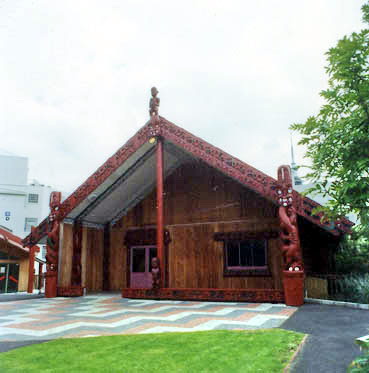
The first weekend of March 2018 is one I’ll never forget. I didn’t go cliff diving into the Pacific or bungee jumping off of the Sky Tower. I didn’t even venture five hundred feet past my apartment. I spent two and a half days with sixty international students at AUT’s 34th International Noho Marae, immersing myself in Maori culture.
The weekend started off with much anticipation. I’d been in the Marae once already, during the Powhiri welcoming ceremony during orientation, but I was eager to step back into the Maori’s sacred meeting grounds. I got to take part in the ceremony again, as you can’t enter the Marae until you’ve participated in the ceremony. The ritual involved a welcome speech given in Maori by Jason King, a Maori and Indigenous Development professor, where he asked us to open our minds and hearts to the experiences we would have this weekend. We concluded with the hongi, which Jason described as one of the most intimate Maori greetings. We moved down the line and touched noses with the Maori staff, their volunteer families, and the other international students.
After practicing some basic Maori words and learning one of the many songs we would be performing at our concert the following evening, it was time for our first meal: an international potluck. All of our meals took place in the Wharekai, the dining hall next to the Marae, as no food, drink, or shoes are allowed inside. With students from Denmark to Malaysia, we had five tables full of food from around the world. But before we could serve ourselves, Elberta Chan, AUT’s international student support manager, informed us of a fundamental Maori custom: “Don’t eat until you’re full, eat until you’re tired.” And eat we did!
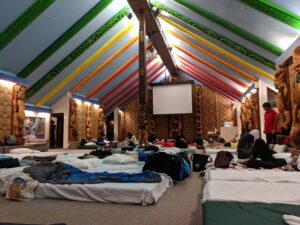
Did I mention that the Noho Marae is also a sleepover? Because even though our apartments were right around the corner, most of the students stayed in the Marae overnight. The Marae provided us with pillows, sheets, and mattresses that we laid out each night and stacked up every morning. After dinner, it was time to relax and eventually head to bed, as we had a packed day on Saturday.
The following morning we woke up bright and early and headed to breakfast. The whole weekend was catered for us by some amazing volunteers who cooked some of the tastiest meals I’ve had in New Zealand so far. Then we headed off to learn our next performance piece: titiorea, the stick game. But don’t be fooled, it’s not as simple as it sounds! Basically, you sing a song while tossing two wooden sticks to the partner sitting across from you. The tricky part is your partner is tossing their set of sticks to you at the same time, so hand-eye coordination is essential. And for those of us who have little to none, this was quite the challenge. Some were definitely better at it than others but it was reassuring to see that even Jason’s sons, who were teaching us the steps, had trouble sometimes.
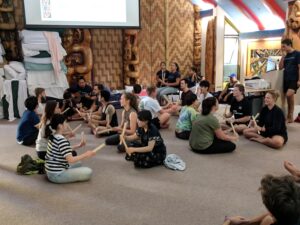
After learning the second song and the motions to go along with it, we broke for lunch. And after lunch, the men and women split off to learn the haka and poi, respectively. The haka is a war cry traditionally performed by Maori men, but now both men and women take part. Performers draw on their mana, their life energy, to channel strength and power for intimidation. The essence of the haka involves a chant and intense dance that usually leaves everyone exhausted and a little bruised. There are many different hakas performed for various occasions which makes it one of the most popular Maori traditions.
The poi, on the other hand, is a tool women perform with to represent femininity and grace. It’s made of stuffing wrapped in plastic and attached to braided yarn. It was traditionally used by warriors for wrist flexibility and dexterity, but Maori women later adapted it. The song lyrics are of deep admiration and appreciation for the poi. The ladies got to make their own poi, learn the song, and how to perform with them for the concert that evening.
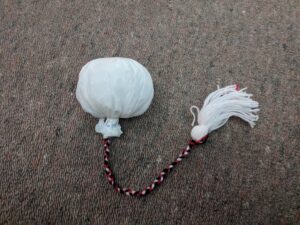
After practicing our songs, the stick game, haka, and poi multiple times over the past twenty-four hours, it was time to perform them at our concert. We were all relieved when we learned our audience would simply be the staff and their families who had been teaching us all weekend. We had a projector with all of the words to our songs and at least two people performing all of the motions behind the audience. It was definitely nerve-wracking to be put to the test after such a short time but our audience loved it and we even gave an encore of our haka and poi performances.
The evening concluded with a hangi feast and bonding at Vesbar, AUT’s campus bar. The hangi is a method of cooking overheated rocks buried in a pit oven. It most closely relates to the American BBQ but is better for vegans and vegetarians like myself because plenty of non-meat options are available. After digesting a ridiculous amount of food, we made our way over to Vesbar, which had been rented to us for the night. We were served pitchers of beer, hard cider, and wine and sang karaoke covers of classics late into the night.
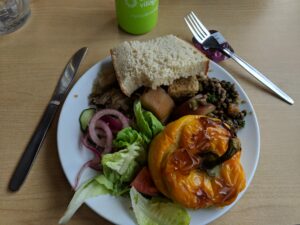
Sunday morning consisted of breakfast and a farewell ceremony. Each country was asked to say a few words in their language and perform a traditional or popular song with the underlying theme of whānau, family. It was really amazing to see this blend of culture after learning so much about the Maori and spending so much time with other international students.
I know this was only one weekend of my four months abroad but so far, it has been my absolute favorite. I can’t think of many other opportunities where you can completely immerse yourself in a culture, learn their customs and songs, take part in their rituals, and have a giant sleepover two nights in a row. But I know everyone who attended had an irreplaceable experience and I hope AUT continues this tradition for many more years down the road.
Charlotte Williams studies professional writing and psychology. She is a tutor at the Writing Center, a writer and editor for the Center for Publishing, and an editor for Champlain’s literary magazine Willard & Maple.